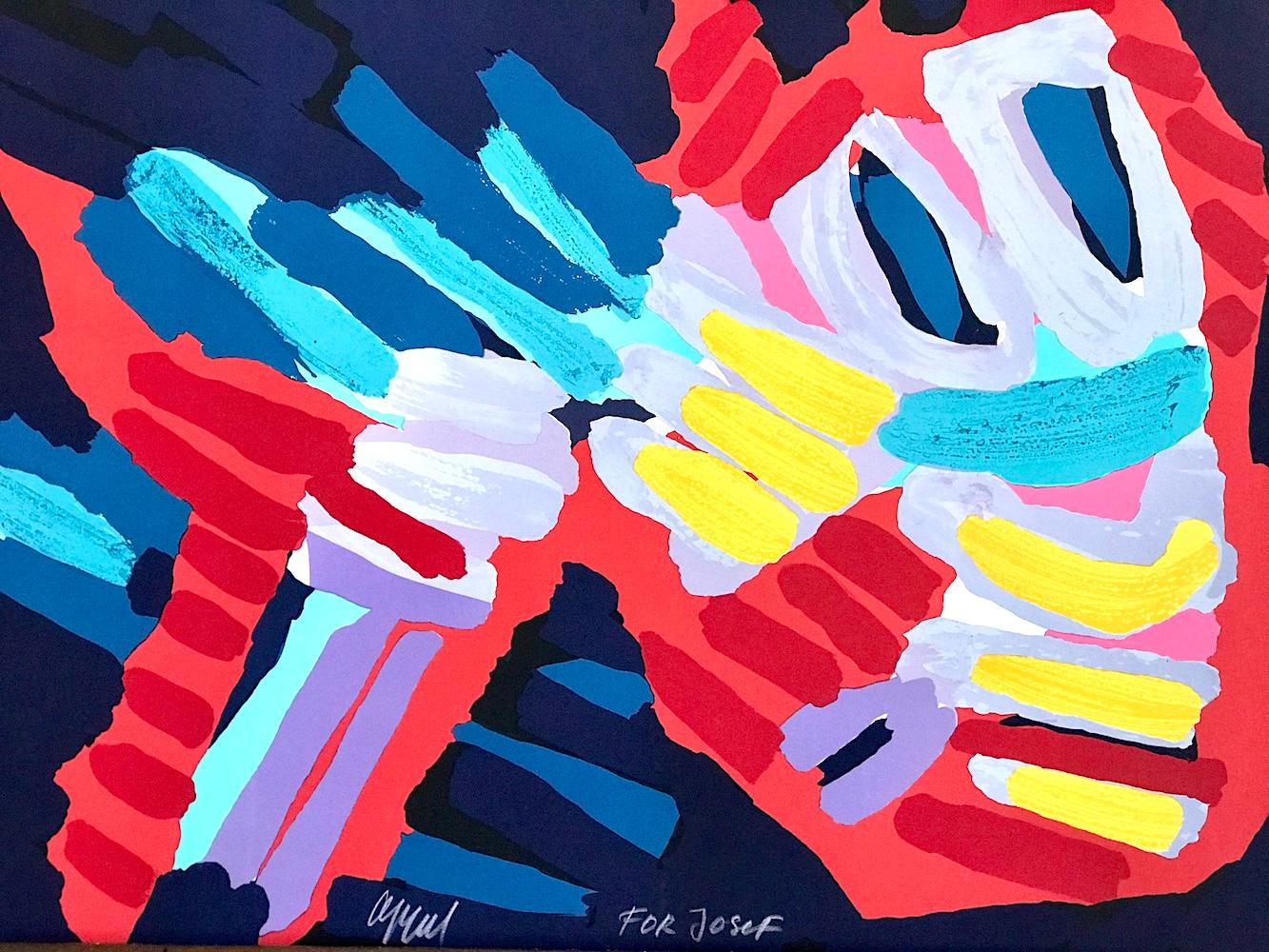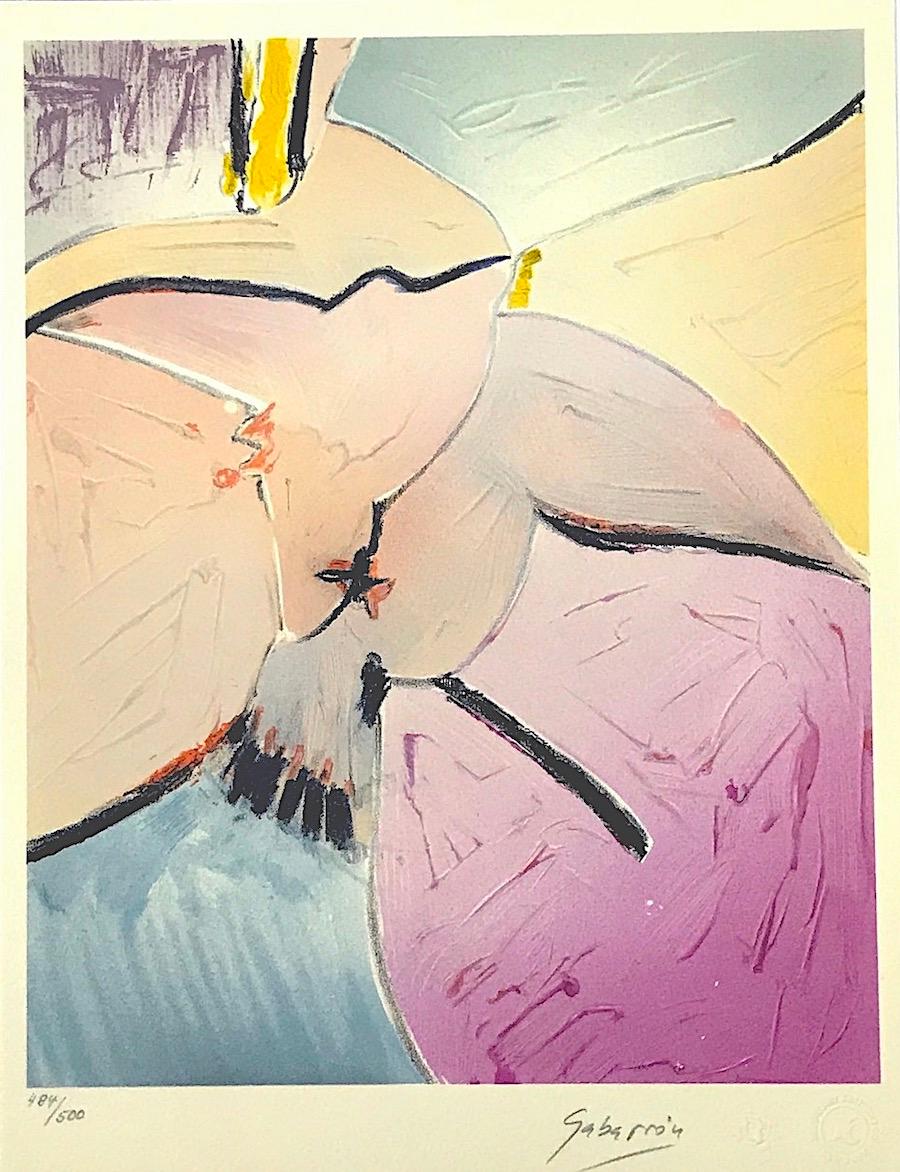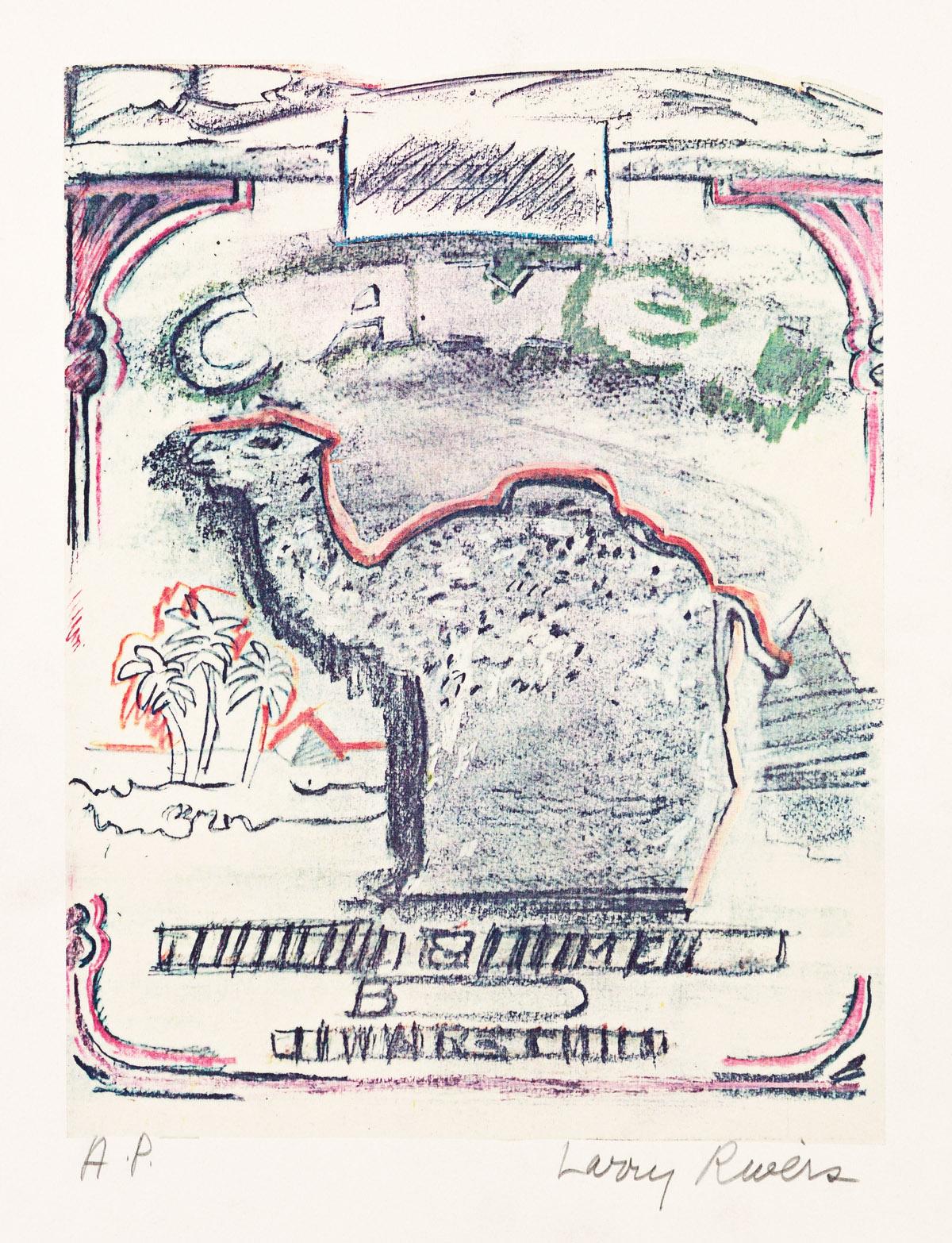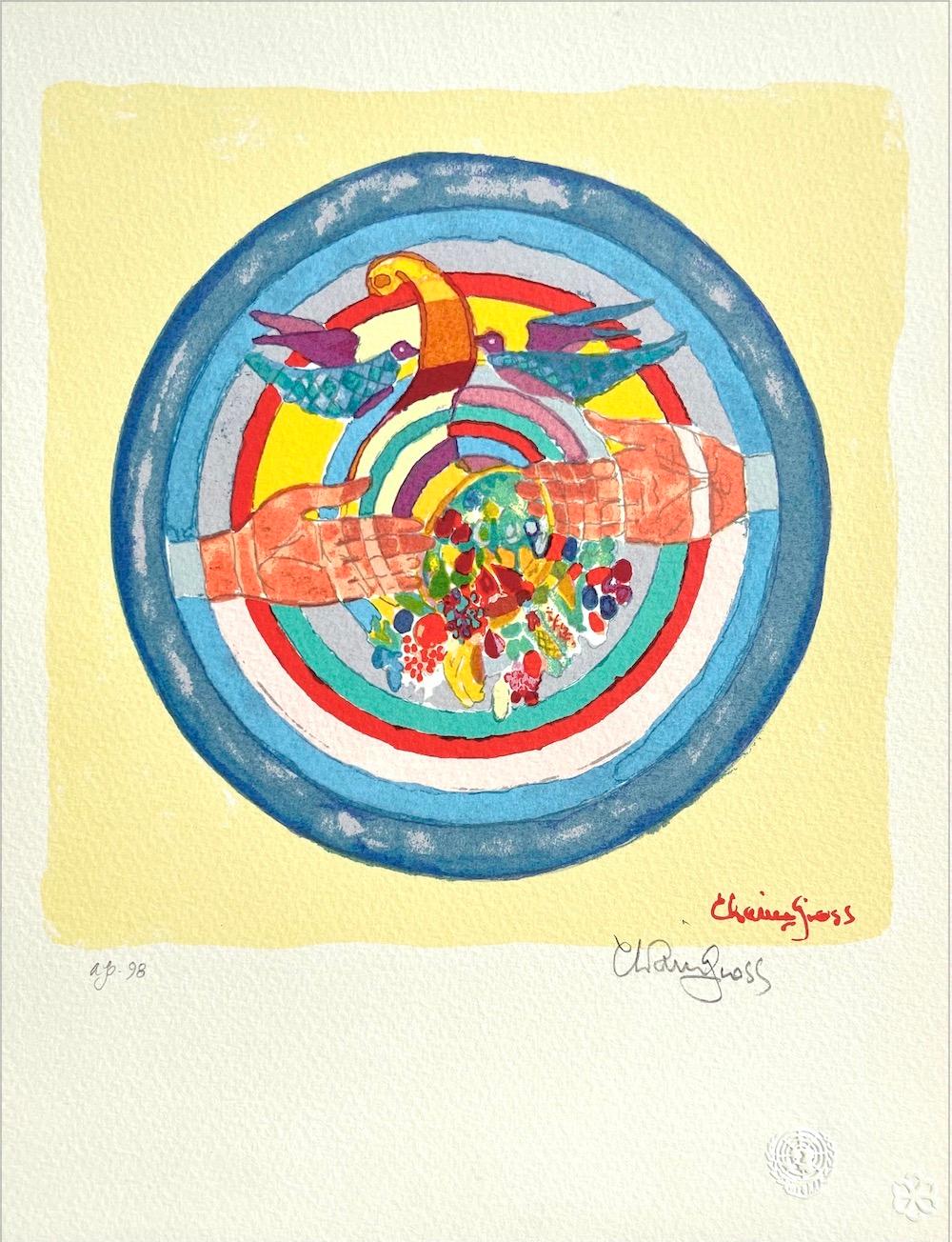Items Similar to "L’Oiseau Vert (The Green Bird)" Expressionist Marc Chagall Exhibition Poster
Want more images or videos?
Request additional images or videos from the seller
1 of 13
"L’Oiseau Vert (The Green Bird)" Expressionist Marc Chagall Exhibition Poster1962
1962
About the Item
A 1962 lithograph poster on paper after a work by renowned Russian-French Expressionist Marc Chagall titled "L’Oiseau Vert (The Green Bird)." The piece was printed by France’s Mourlot Studios for an exhibition of Chagall’s work at Paris’s Galerie Maeght in June and July of 1962. The work features a large bird as well as a pair of embracing figures set against a pastel blue and green background. Hung in a silver metal frame with a complementary light blue matting.
Dimensions Without Frame: H 25.5 in. x W 20.75 in.
Artist Biography: Marc Chagall was a man of keen intelligence, a shrewd observer of the contemporary scene, with a great sympathy for human suffering. He was born on July 7, 1887 in Vitebsk, Russia; his original name was Moishe Shagal (Segal), but when he became a foremost member of the Ecole de Paris, he adopted French citizenship and the French spelling of his name. Vitebsk was a good-sized Russian town of over 60,000, not a shtetl. His father supported a wife and eight children as a worker in a herring-pickling plant.
Sheltered by the Jewish commandment against graven images, the young Chagall never saw so much as a drawing until, one day, he watched a schoolmate copying a magazine illustration. He was ridiculed for his astonishment, but he began copying and improvising from magazines. Both Chagall's parents reluctantly agreed to let him study with Yehuda Pen, a Jewish artist in Vitebsk. Later, in 1906, they allowed their son to study in St. Petersburg, where he was exposed to Russian Iconography and folk art. At that time, Jews could leave the Pale only for business and employment and were required to carry a permit. Chagall, who was in St. Petersburg without a permit, was imprisoned briefly.
His first wife, Bella Rosenfeld, was a product of a rich cultivated and intellectual group of Jews in Vitebsk. Chagall was made commissar for the arts for the area, charged with directing its cultural life and establishing an art school. Russian folklore, peasant life and landscapes persisted in his work all his life. In 1910 a rich patron, a lawyer named Vinaver, staked him to a crucial trip to Paris, where young artists were revolutionizing art. He also sent him a handsome allowance of 125 francs (in those days about $24) each month. Chagall rejected cubism, fauvism and futurism, but remained in Paris. He found a studio near Montparnasse in a famous twelve-sided wooden structure divided into wedge-shaped rooms. Chaim Soutine, a fellow Russian Jew, and Modigliani lived on the same floor. To Chagall's astonishment, he found himself heralded as one of the fathers of surrealism. In 1923, a delegation of Max Ernst, Paul Eluard and Gala (later Salvador Dali's wife) actually knelt before Chagall, begging him to join their ranks. He refused.
To understand Chagall's work, it is necessary to know that he was born a Hasidic Jew, heir to mysticism and a world of the spirit, steeped in Jewish lore and reared in the Yiddish language. The Hasidim had a special feeling for animals, which they tried not to overburden. In the mysterious world of Kabbala and fantastic ancient legends of Chagall's youth, the imaginary was as important as the real. His extraordinary use of color also grew out of his dream world; he did not use color realistically, but for emotional effect and to serve the needs of his design. Most of his favorite themes, though superficially light and trivial, mask dark and somber thoughts. The circus he views as a mirror of life; the crucifixion as a tragic theme, used as a parallel to the historic Jewish condition, but he is perhaps best known for the rapturous lovers he painted all his life. His love of music is a theme that runs through his paintings.
After a brief period in Berlin, Chagall, Bella and their young daughter, Ida, moved to Paris and in 1937 they assumed French citizenship. When France fell, Chagall accepted an invitation from the Museum of Modern Art to immigrate to the United States. He was arrested and imprisoned in Marseilles for a short time, but was still able to immigrate with his family. The Nazi onslaught caught Chagall in Vichy, France, preoccupied with his work. He was loath to leave; his friend Varian Fry rescued him from a police roundup of Jews in Marseille, and packed him, his family and 3500 lbs. of his art works on board a transatlantic ship. The day before he arrived in New York City, June 23, 1941, the Nazis attacked Russia. The United States provided a wartime haven and a climate of liberty for Chagall. In America he spent the war years designing large backdrops for the Ballet.
Bella died suddenly in the United States of a viral infection in September 1944 while summering in upstate New York. He rushed her to a hospital in the Adirondacks, where, hampered by his fragmentary English, they were turned away with the excuse that the hour was too late. The next day she died.
He waited for three years after the war before returning to France. With him went a slender married English girl, Virginia Haggard MacNeil; Chagall fell in love with her and they had a son, David. After seven years she ran off with an indigent photographer. It was an immense blow to Chagall's ego, but soon after, he met Valentine Brodsky, a Russian divorcee designing millinery in London (he called her Fava). She cared for him during the days of his immense fame and glory. They returned to France, to a home and studio in rustic Vence. Chagall loved the country and every day walked through the orchards, terraces, etc. before he went to work.
Chagall died on March 28, 1985 in the south of France. His heirs negotiated an arrangement with the French state allowing them to pay most of their inheritance taxes in works of art. The heirs owed about $30 million to the French government; roughly $23 million of that amount was deemed payable in artworks. Chagall's daughter, Ida and his widow approved the arrangement.
- Creation Year:1962
- Dimensions:Height: 31.25 in (79.38 cm)Width: 26.25 in (66.68 cm)Depth: 0.88 in (2.24 cm)
- Medium:
- Movement & Style:
- After:(after) Marc Chagall (1887 - 1985, French, Russian)
- Period:
- Condition:
- Gallery Location:Houston, TX
- Reference Number:

About the Seller
5.0
Vetted Seller
These experienced sellers undergo a comprehensive evaluation by our team of in-house experts.
Established in 1969
1stDibs seller since 2014
784 sales on 1stDibs
Typical response time: 7 hours
- ShippingRetrieving quote...Ships From: Houston, TX
- Return PolicyA return for this item may be initiated within 7 days of delivery.
More From This SellerView All
- "Marsupial" Abstract Impressionist Lithograph of a Kangaroo Edition 3 of 4By Paul SprohgeLocated in Houston, TXAbstract animal lithograph of a kangaroo. The work is framed in a gold frame with a white matte. It is signed, dated and titled by the artist. Paul Sprohge is a Houston, Texas artist...Category
1970s Impressionist Animal Prints
MaterialsLithograph
- "Feline and Ladders" Limited Edition Serigraph Print Edition 13 of 50By Yankel GinzburgLocated in Houston, TXAbstract serigraph of a cat with organic forms. This serigraph is a limited edition. The artist signed titled and dated the work. It is framed in a gold frame with a white matte. Dim...Category
1980s Modern Abstract Prints
MaterialsLithograph
- “Perro Herido (Wounded Dog)” from 90th Anniversary Suite Lithograph Ed. 22/110By Rufino TamayoLocated in Houston, TXAbstract surrealist lithograph of a dog wounded by an arrow. This work is from his 90th anniversary suite, the last prints Tamayo completed, before passing on. Signed and editioned a...Category
1980s Surrealist Animal Prints
MaterialsLithograph
- "El Grito" Surrealist Print in a Cubist Style Edition 39 of 100Located in Houston, TXCubist style woodblock print of sun with an eagle. The woodblock is neutral-toned with greens and yellows. The work is titled and signed by the artist. The work is framed in a black ...Category
20th Century Cubist Abstract Prints
MaterialsWoodcut
- “Truth is Stranger than Fiction” Black and White Abstract Etching Edition 4/15By Margaret Smithers CrumpLocated in Houston, TXBlack and white abstract etching by Houston artist Margaret Smithers-Crump. The work features a collection of abstracted sea creatures such as a crab, eel, and puffer fish. Signed, t...Category
1980s Abstract Abstract Prints
MaterialsEtching
- “Ghost Riders” Abstract Modern Grey Toned Intertwined Snail Screen Print Ed 9/15Located in Houston, TXAbstract modern screen print of a pair of intertwining snails floating against a grey toned ombre background. Signed, titled, and editioned along the lower edge of the print. Current...Category
1990s Abstract Animal Prints
MaterialsScreen
You May Also Like
- SPACE VOYAGE Signed Lithograph, Outer Space Creatures, Latin American ArtistBy Raquel FornerLocated in Union City, NJSPACE VOYAGE is an original hand drawn lithograph by the Latin American Woman artist Raquel Forner, paper size - 13 1/4" x 15 1/4", image size - 8 1/2" x 11 3/4" printed in warm red...Category
1980s Expressionist Abstract Prints
MaterialsLithograph
- SLEEPY BIRD, Signed Lithograph, Abstract Bird, Smiling Face, Red Yellow LavenderBy Karel AppelLocated in Union City, NJSLEEPY BIRD is an original limited edition lithograph by the Dutch artist Karel Appel printed using hand lithography techniques on Arches paper, 100% acid free. SLEEPY BIRD is a live...Category
1970s Abstract Animal Prints
MaterialsLithograph
- WITH MY PUSSYCAT Signed Lithograph, Abstract Animal, Blue Cat, CoBrA ArtistBy Karel AppelLocated in Union City, NJWITH MY PUSSYCAT is an original limited edition lithograph by the Dutch artist Karel Appel printed using hand lithography techniques on archival, 100% acid free printmaking paper. WITH MY PUSSYCAT is a lively, imaginative, multi-color abstract animal composition portraying a cat figure with black eyes, and body colors of red, light yellow, turquoise blue, purple, pink and royal blue against a deep black background. The cat's companion positioned on the right, also outlined in turquoise blue takes on a more human form exhibiting abstracted facial features comprised of painted dabs of yellow and blue for eyes, a long blue nose...Category
1970s Abstract Animal Prints
MaterialsLithograph
- HOPES FOR PEACE Signed Lithograph Abstract Dove, Airbrush Colors, Spanish ArtistLocated in Union City, NJHOPES FOR PEACE is a handmade color lithograph by the internationally recognized Spanish artist Cristóbal Gabarrón printed on archival Arches printmaking paper in 1986. HOPES FOR PEA...Category
1980s Contemporary Abstract Prints
MaterialsLithograph
- Camel, Larry RiversBy Larry RiversLocated in Fairfield, CTArtist: Larry Rivers (1923-2002) Title: Camel Year: 1980 Medium: Color lithograph on wove paper Edition: 75, plus proofs Size: 11.13 x 8.64 inches Condition: Excellent Inscription: Signed & inscribed A.P. in pencil, lower margin Notes: Larry Rivers is considered by many to be the father of the Pop Art movement. In Rivers's 1980 work "Camel," we see a slightly out of focus Camel Cigarette pack, an item from consumer culture Rivers has appropriated to create a critique of commoditization and consumer culture. Rivers would have certainly been aware of the work of Stuart Davis and his 1921 painting...Category
1980s Pop Art Abstract Prints
MaterialsLithograph
- NEW INTERNATIONAL ECONOMIC ORDER Signed Serigraph, Abstract Cornucopia, FruitBy Chaim GrossLocated in Union City, NJ"NEW INTERNATIONAL ECONOMIC ORDER" is a brightly colored serigraph by the American artist/sculptor Chaim Gross printed in 16 colors including shades of yellow, blue, purple, salmon p...Category
1970s Contemporary Abstract Prints
MaterialsLithograph
Recently Viewed
View AllMore Ways To Browse
Large Exhibition Poster
Large Art Exhibition Poster
The Specials Poster
Paris 1937 Poster
South America Vintage Posters
Dali Exhibition
Chagall Original Painting
Marc Chagall Museum
Chagall Original Framed
Marc Chagall Exhibition
Retro Childrens Posters
Green Cubism
Jewish L
Marc Chagall Museum Of Modern Art
Group Of Bird Prints
The Birds Poster
French Wooden Green
Chagall Lovers




